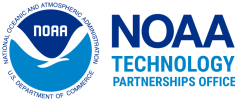A record number of NOAA Cooperative Research and Development Agreements in 2021 has generated scientific and economic benefits
Research partnerships are increasingly important as scientists work to address complex global problems like coastal resilience, food security, and climate change. Public-private partnerships, in particular, are vital for bringing private sector innovation and agility into NOAA’s research and development efforts. One of the key tools in NOAA’s partnership toolkit is the CRADA, or Cooperative Research and Development Agreement.
A CRADA is a formal agreement that allows federal and non-federal partners to do collaborative research and further develop new science into commercially-available products. CRADAs connect NOAA Laboratories or Science Centers with private U.S. companies, universities, and other entities, creating scientific partnerships across NOAA’s mission areas. CRADAs are valuable because they allow NOAA and non-federal partners to share ideas, technical expertise, facilities, and other research materials.
The NOAA Technology Partnerships Office (TPO) is responsible for managing all of NOAA’s CRADAs. During Fiscal Year 2021, TPO initiated 18 new CRADAs, which is the highest number of these agreements ever to be started in one year at NOAA. This represents a 28% increase in the total number of new CRADAs from the previous fiscal year. Furthermore, NOAA and its research partners benefitted from a total of 57 active CRADAs this year, representing an increase of 24% from 2020. The number of CRADAs at NOAA is increasing as more federal researchers and non-federal partners see the value of existing public-private research and development efforts.
Collaborations between NOAA and private-sector innovators accelerate research and development that supports both NOAA’s operations and commercialization within the private sector. This is important because more people can benefit from cutting-edge scientific discoveries and inventions when they are available on the commercial market. One example of an ongoing CRADA collaboration is NOAA’s partnership with U.S. biotechnology company, Prospective Research, Inc. NOAA researchers developed a probiotic to prevent disease in oysters and then began a public-private partnership with Prospective Research to further develop and test a freeze-dried version of the formula. The new shelf-stable probiotic has been shown to increase the survival rate of oyster larvae by 20-30% and is expected to be commercially available in 2022. The probiotic has the potential to increase sustainable aquaculture production worldwide.
Another partnership between NOAA and the U.S. business, Saildrone, has simultaneously increased NOAA’s capacity to conduct innovative research and provide high-quality climate services, while also directly benefiting Saildrone and the U.S economy, more broadly. NOAA and Saildrone entered into a CRADA to explore how the company’s ocean drone technology could be further developed and strategically used to collect environmental data. Saildrone’s products have since been modified to support diverse NOAA research projects in the Arctic, across fisheries, around Antarctica, and even in the eye of a hurricane. The hurricane-equipped Saildrone Explorer was recently named one of the 100 Greatest Innovations of 2021.
Video footage from on board Saildrone 1045 and animation showing location in Hurricane Sam on Sept. 30, 2021.
As a result of this fruitful research partnership, NOAA scientists have been able to use the newly-collected data to improve storm forecasts, fisheries management, and climate services, while Saildrone has enjoyed a significant boom in business. According to a 2019 economic valuation study, during the three years after the 2014 CRADA with NOAA was established, Saildrone expanded their workforce from eight to over 100 employees and secured over $95 million in third-party investments into their technology. This influx of interest and sales can be partially attributed to the perceived scientific rigor associated with NOAA’s involvement in Saildrone’s product development. The economic benefits of Saildrone’s technology continue to increase– in October 2021, Saildrone announced the close of its $100 million Series C funding round. The company’s continued growth and success is creating jobs in several industries and is a significant asset for U.S. economies, especially in areas where Saildrones are created and deployed.
While the NOAA-Saildrone partnership has been particularly successful, the cumulative impact of more than 50 active NOAA CRADAs underway cannot be overstated from either a scientific or an economic perspective. The collaborations increase NOAA’s capacity to do scientific research, while also stimulating technological innovation and generating broad economic value for the U.S. economy, the global New Blue Economy, and individual U.S. businesses. This economic impact was particularly important during the global COVID pandemic, so it is especially notable that NOAA reached its highest-ever annual number of new CRADAs during Fiscal Year 2021.
Over the next year, TPO hopes to continue to expand NOAA’s use of CRADAs as a way to create partnerships. TPO is working with NOAA scientists and engineers to help them evaluate how a CRADA or other type of research partnership can most effectively support their research objectives. TPO also serves as the lead of the Partnerships Working Group under the Science and Technology Synergy Committee of the NOAA Science Council. TPO will continue to highlight the many ways that public-private partnerships support NOAA’s mission and stimulate innovation of new products bound for the commercial market. As scientific research is called upon to inform solutions for some of society’s most pressing challenges, partnerships are essential and CRADAs unlock enormous potential for collaborative problem-solving and innovation.
